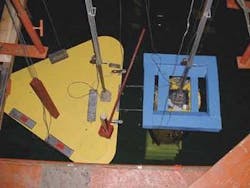Dry tree enables tendered mooring in deepwater
Christopher Beato,Drillmar Inc.
David Tein (M), Donghui Chen (M), Amit Katarya (AM)
David Tein Consulting Engineers Ltd.
Costs go up as drilling moves into deeper water. The challenge to the offshore industry is to find ways to efficiently develop deepwater reserves. Dry tree floating production units (DTUs) have evolved to a point at which they can improve cost savings. In fact, DTUs are being very cost effectively constructed in 22 months based on standardized detailed designs.
Drillmar's coupled tender mooring solution enables both drilling and production operations to be conducted from these standardized units. A passive mooring system synchronizes the low frequency movements of a semisubmersible vessel to a DTU, maintaining their relative positions to provide an efficient and safe tender operation. To date, the most frequently used shallow-water field development strategy has been a small wellhead platform and a jackup drilling rig. Drillmar's tender mooring solution enables operators to implement a similar, proven, dry-tree approach in the deepwater environment.
Tender systems and applications
Coupled tender mooring systems have been designed for various semisubmersible tenders as well as floating dry-tree units and their respective mooring/tethering systems.
The coupled mooring concept was evaluated for use in the Gulf of Mexico and off Brazil and West Africa at water depths ranging from 1,500 ft to 6,000 ft. Though tests did not calculate capabilities at depths greater than 10,000 ft, there is no foreseen barrier to extending the concept to that depth.
Mooring systems and performance
The tender mooring system is composed of proven components and employs practical rig wire size (around 4.5 in. for the GoM) that can be handled by a conventional winch. Depending on the semisubmersible tender's shape and size, both 8- and 9-point taut-leg wire-polyester spread mooring systems were evaluated. The coupled mooring system has two hawsers to give 100% redundancy and is sized for practical handling with a breaking strength of 1,000 kips.
The test system is set up with the tender moor-ed 600-1,000 ft from the DTU at the standby position. Then, the tender is winched close to the tender operating position. Hawsers are paid out from the winches on the tender and connected to the DTU. Finally, the Spar mooring system or TLP auxiliary mooring lines and the tender mooring system are used to pull around 120 kips tension in each hawser.
The mooring system design allows for passive mooring in up to one-year storm conditions.
Tender operability
Using a coupled tender mooring system increases uptime, operational efficiency, and safety. Three features of the coupled tender mooring system improve tender operability.
The first is that no matter what the weather or what line breaks, the coupled mooring system ensures prudent hull clearances (> 10 m), eliminating the risk of collision.
Second, out of phase movement of the vessels in the horizontal plane can be reduced to around 24 ft, which increases crane operability. Independent mooring during or approaching the one-year storm is not operationally practical since the movement can be as much as 87 ft, which could potentially create conflict problems between the crane and the drilling equipment set and other production platform facilities.
Third, tender operability can be well gauged by the operability of the walkway (the telescopic personnel bridge connecting the DTU with the tender during well operations). The coupled mooring system greatly reduces the walkway stroke, compared to an independently moored alternative. The maximum extended walkway length for the coupled mooring system is 97 ft. This length for an independent mooring system is 193 ft.
In unexpected severe winter weather, it is always possible to disconnect umbilicals and the bridge without compromising personnel safety and to move to a standby position with hawsers still attached but slackened.
The hawser winch is designed to limit maximum tension in the hawser to 50-60% of the breaking strength. This design minimizes the chance of breaking a hawser to accommodate unanticipated peak loads during a winter storm.
Model test validation
The coupled tender mooring concept for Spar and TLP designs was validated for the DM2000 semisubmersible tender in combination with a generic truss-Spar (90-ft diameter by 540-ft height) at Offshore Model Basin in September 2001. The main objective of the test program was to confirm the operability of the mooring system for tender operations in the GoM winter storms and loop currents, including damaged mooring scenarios.
Winter-storm tests confirm that the coupled mooring indeed synchronizes the mean and low-frequency responses between the two vessels in the governing 0° (tender upwave) and 180° (spar upwave) headings. This mooring arrangement significantly enhanced tender operability by reducing the gangway stroke and required hull clearance. Under an uncoupled mooring arrangement, these two vessels show distinctively different low frequency (LF) periods and phases. Out-of-phase movements in this case are imminent, and this finding is consistent with analytical simulations.
Loop-current tests show that the truss-Spar experienced insignificant vortex-induced-oscillations, around 5 ft double-amplitude range (d/D ratio ~ 5%) at a period of around 200 sec, which is the mooring natural period of the Spar in lateral translation. The presence of a down-current tender has no effect on the Spar vortex-induced vibration (VIV). An up-current tender increases the turbulence at the Spar, but the impact on Spar VIV seems secondary. Similarly, coupled or uncoupled moorings show little effect on VIV except for small modification of the VIV oscillation periods.
Measured mooring hawser tensions confirmed that LF responses are manageable and that wave frequency out-of-phase motions are the dominant source of hawser dynamic tensions. Measured hawser tensions were higher than analytical simulations by a significant margin, but present no barriers for the design of a robust hawser mooring system. Both the causes and solutions are identified.
Coupled mooring system
A coupled tender mooring has been designed for a DTU: Spars and TLPs operating in 1,500-6,000 ft water depth in the GoM, Brazil, and West Africa. The tender mooring system consists of a taut-leg spread mooring designed to withstand the 100-year storm, the same stringent criteria for permanently mooring a floater. The coupled mooring, with patented dual-hawsers, is a passive system for tender operations up to the one-year storm conditions. Beyond these weather limits, the mooring hawsers would be disconnected, and the tender would be moved to an operating standby position 200 ft away from the DTU. During hurricanes or 100-year storms, the tender would be moved to a survival standby position, 600-1,000 ft from the DTU.
Coupled tender mooring passively synchronizes the mean and low-frequency motions between the tender and DTU, and consequently, offers operational advantages over an independently moored tender, including:
- Maintaining safe hull clearance, in particular, the ability to cope with sudden breaking of a mooring line
- Enhancing crane and gangway uptimes due to reduced relative vessel motions
- Minimizing active mooring adjustments by using a passive dual-hawser mooring to couple the tender with DTU.
Wave-basin tests were carried out for a semisubmersible tender with a generic truss-Spar, operating in 6,000 ft of water in the GoM. Model tests confirm the design principles of the coupled tender mooring system and offer valuable insights for continuing design optimization.
Acknowledgements
The authors are grateful to SparTEC and CSO Aker, which offered the information and the test model of the truss-Spar. The authors would also like to thank to the staff of OMB for their efforts in the model test.
Authors
Christopher Beato, P.E. is the vice president of Drillmar Inc., an engineering and drilling contractor focused on providing offshore multipurpose units. A graduate of the Colorado School of Mines, he has been involved with deepwater projects since 1987 as a member of Conoco's Jolliet TLWP development team.
David Tein, Ph.D, P.E. formed David Tein Consulting Engineers Ltd. in 1992. DTCEL has designed more than fifty deepwater mooring systems for semisubmersibles, tankers, Spars and TLPs. DTCEL also has extensive experience in riser design and analysis. The company has organized and directed three joint industry projects focused on VIV experiments and software tools since 1996.
Donghui Chen joined DTCEL after receiving his M.S. degree from Virginia Tech in 2000. Since then, he has been involved in projects, including vessel motion analyses, station keeping and mooring performance analyses, and riser analyses, as well as engineering software development. He also has experience with ABS, Singapore and Shanghai Marine Equipment Research Institute.
Amit Katarya received his B.Tech. (Honors) degree from Indian Institute of Technology, Kharagpur in 1999 and M.S. degree from the University of New Orleans in 2000. At DTCEL he is involved in station keeping, mooring system analyses and design, and riser analyses and design projects.
Editor's Note: This article was adapted from a technical paper presented at the SNAME 11th Offshore Symposium, Houston, Texas, Feb. 20, 2002, "Coupled Tender Mooring for Spar and TLP Designs," Christopher L. Beato, David Tein, Donghui Chen, and Amit Katarya.




